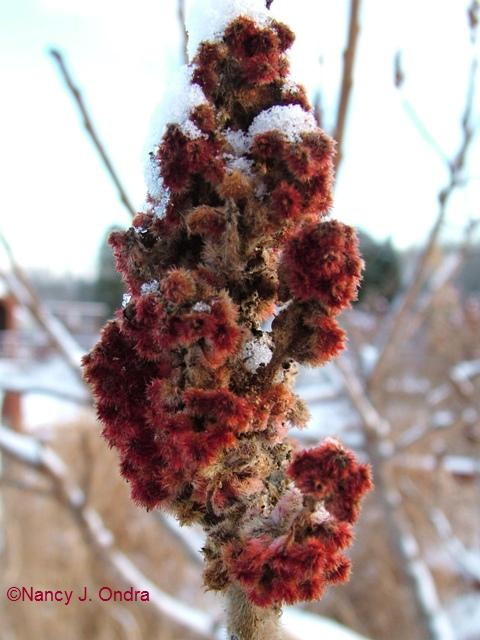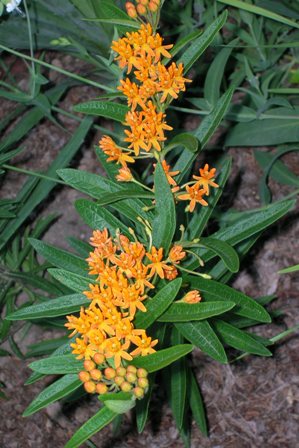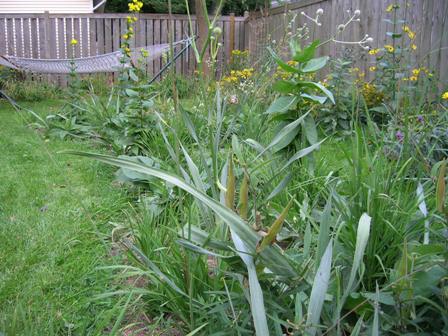[Note from Fran: We are delighted to have Andrea Kramer join us as a Guest Contributor on GGW. Andrea is Executive Director of the U.S. office of Botanic Gardens Conservation International based at Chicago Botanic Garden. Prior to taking up her current post with BGCI in January 2008, Andrea worked for 8 years in the conservation science department at CBG. Her work initially involved research on rare Midwestern prairie plants, and later projects led to collaborations between the Center for Plant Conservation and its many member botanic gardens throughout the United States.]
For over eight years now, I have been paid to come to one of the most beautiful places in the world on a daily basis. I get to spend my days thinking and talking about plants and am surrounded by people who are as excited by what plants bring to our planet as I am. Could life get any better?
The path that brought me to this incredible place and fulfilling role is as winding as any life path. I have only recently realized it, but plants have always been growing along and leading me down this path, as they are my source of inspiration, hope, and tranquility. I know that I am not alone in finding so much of my life connected to plants, but I do feel incredibly lucky that I have been able to craft a career that gives me the tools to give back to plants even a portion of what they give me.
Plants were an integral part of life in the small Midwestern farming town where I grew up. As a child I loved car trips on the gravel roads outside of town, because they provided ample opportunity to gaze out the window and watch row after row of corn and soybeans whir by. Throughout high school, I spent my summers in those repeating rows of corn, working at a crop breeding station and helping to create the next generation of hybrid corn releases. In this place, machinery, fine-tuned plant breeding, fertilizers, chemicals, and the use of ancient water stored for millennia in an underground aquifer allowed people to tame the natural unpredictability of plants and weather in order to feed the world.
 With a premium placed on uniformity and straight lines, very little diversity or divergent paths were visible in this landscape. But they were there if you looked hard enough. One of my favorite sights was monarchs laying eggs on the milkweed (emphasis on weed here) growing in the ditches next to an endless sea of corn. If this species wasn’t so hardy and difficult to get rid of, it would join the hundreds of other prairie species who, having helped build the soils now yielding bountiful harvests, ultimately succumbed to the plow and now exist in tiny postage stamps of remnant prairie.
With a premium placed on uniformity and straight lines, very little diversity or divergent paths were visible in this landscape. But they were there if you looked hard enough. One of my favorite sights was monarchs laying eggs on the milkweed (emphasis on weed here) growing in the ditches next to an endless sea of corn. If this species wasn’t so hardy and difficult to get rid of, it would join the hundreds of other prairie species who, having helped build the soils now yielding bountiful harvests, ultimately succumbed to the plow and now exist in tiny postage stamps of remnant prairie.
 And I remember my first trip to one of those remnant prairies (the closest of which required a 50 mile drive), where literally hundreds of plant species were growing on top of each other in an overwhelming display of diversity, beauty, and a subtle natural pattern that was incredibly soothing. One plant in particular really stuck with me: staghorn sumac (Rhus typhina). I don’t know if it was because of its fuzzy stems, the incredible cluster of fuzzy red fruit, or the story of how the Native Americans only 100 years before we were there would use those fuzzy red berries to make tea. Plants and people interacting in a landscape I could only barely make out. I was fascinated.
And I remember my first trip to one of those remnant prairies (the closest of which required a 50 mile drive), where literally hundreds of plant species were growing on top of each other in an overwhelming display of diversity, beauty, and a subtle natural pattern that was incredibly soothing. One plant in particular really stuck with me: staghorn sumac (Rhus typhina). I don’t know if it was because of its fuzzy stems, the incredible cluster of fuzzy red fruit, or the story of how the Native Americans only 100 years before we were there would use those fuzzy red berries to make tea. Plants and people interacting in a landscape I could only barely make out. I was fascinated.
Cut to today. My husband and I are standing at a native plant sale in the frigid rain, trying to find just the right plants to make the space in our backyard look less like a weed patch and more like a prairie. After 3 years of work, our “prairie” is starting to take shape. But to many of our neighbors, it still resembles a patch of weeds. They are more than happy to maintain their weed-free lawn on the other side of our fence.
But to others, what we have is a rare gem, and it is these visitors who I care the most about. I am talking about the goldfinches that eat the seeds from our coneflowers, the bumblebees that happily collect nectar and pollen from our great blue lobelia, or the hummingbirds that dive over the fence and happily hum between our scarlet cardinal flowers to drink their life-sustaining sugary nectar.
 And last year, I became the proud parent of several monarch butterflies. Yes, our milkweed (many species, including the brilliant orange butterfly milkweed or Asclepias tuberosa) had played successful hosts to numerous monarch eggs, caterpillars, chrysalis, and ultimately, a new generation of butterflies.
And last year, I became the proud parent of several monarch butterflies. Yes, our milkweed (many species, including the brilliant orange butterfly milkweed or Asclepias tuberosa) had played successful hosts to numerous monarch eggs, caterpillars, chrysalis, and ultimately, a new generation of butterflies.
Despite this arguable success, we still have a long way to go. Yes, I work at a botanic garden, and one that is a national leader in caring for and conserving the plants that called this place home centuries before we did. I can tell you all about how botanic gardens around the world are working to understand and care for the world’s estimated 400,000 plant species, and how we are working everyday to help reach the targets for the North American Botanic Gardens Strategy for Plant Conservation. But I can’t tell my husband where this potted plant, with fuzzy stems and an incredible cluster of fuzzy red fruit which we are now standing in front of in the freezing rain, would thrive in our prairie garden. I don’t know if we have the right space for this lovely little staghorn sumac plant. And I have trouble explaining why it would mean so much to have it growing just outside my window. So we left the plant for another buyer that day.
But as I continue to learn the landscape of my backyard, you can bet that I will be searching for just the right place to plant next year’s sumac so both it and I can thrive.

